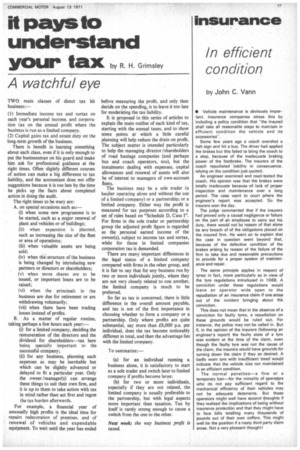it pays to understand
Page 39

If you've noticed an error in this article please click here to report it so we can fix it.
your tax by R. H. Grimsley
A watchful eye
TWO main classes Of direct tax hit business:—
(fl Immediate income tax and surtax on each year's personal income, and corporation tax on the annual profit where the business is run as a limited company.
(2) Capital gains tax and estate duty on the long-term growth of the business.
There is benefit in learning something about each class, even if it is only enough to put the businessman on his guard and make him ask for professional guidance at the right times. Often slightly different courses of action can make a big difference to tax liability, and the accountant does not offer suggestions because it is too late by the time he picks up the facts about completed action in doing the audit.
The right times to be wary are: A. on special occasions such as:— (i) when some new programme is to be started, such as a major renewal of plant and vehicles or of buildings; (ii) when expansion is planned. such as increasing the size of the fleet or area of operations; (iii) when valuable assets are being sold; (iv) when the structure of the business is being changed by introducing new partners or directors or shareholders; (v) when more shares are to be issued, or important loans are to be raised; (vi) when the principals in the business are due for retirement or are withdrawing voluntarily; (vii) when there have been trading losses instead of profits.
B. As a matter of regular routine. taking perhaps a few hours each year:—
(i) for a limited company, deciding the remuneration of the directors and the dividend for shareholders—tax here being specially important to the successful company: (ii) for any business, planning such expenses as may be inevitable but which can be slightly advanced or delayed to fit a particular year. Only the owner/manager(s) can arrange these things to suit their own firm, and it is up to them to take action with tax in mind rather than act first and regret the tax burden afterwards.
For example, a financial year of unusually high profits is the ideal time for repairs redecoration of premises. and of renewal of vehicles and expendable equipment. To wait until the year has ended
before measuring the profit, and only then decide on the spending, is to leave it too late for moderating the tax liability.
It is proposed in this series of articles to explain the main outline of each kind of tax. starting with the annual taxes, and to show some points at which a little careful planning will help reduce the drain on profit. The subject matter is intended particularly to help the managing director /shareholders of road haulage companies (and perhaps bus and coach operators, too), but the instalments dealing with expenses, capital allowances and renewal of assets will also be of interest to managers of own-account fleets.
The business may be a sole trader (a haulier operating alone and without the use of a limited company) or a partnership; or a limited company. Either way the profit is measured for tax purposes according to a set of rules based on "Schedule D, Case I".
For firms in the sole trader or partnership group the adjusted profit figure is regarded as the personal earned income of the owner(s), subject to income tax and surtax, while for those in limited companies corporation tax is demanded.
There are many important differences in the legal status of a limited company compared with firms in the other group, and it is fair to say that for any business run by two or more individuals jointly, where they are not very closely related to one another, the limited company is much to be preferred.
So far as tax is concerned, there is little difference in the overall amount payable, and tax is not of the first importance in choosing whether to form a company or a partnership. Only where profits are quite substantial, say more than £8,000 p.a. per individual, does the tax become noticeably different in total, and then the advantage lies with the limited company.
To summarize:—
(a) for an individual running a business alone, it is satisfactory to start as a sole trader and switch later to limited company if profits become large:
(b) for two or more individuals, especially if they are not related, the limited company is usually preferable to the partnership, but with legal aspects more important than taxation. Tax by itself is rarely strong enough to cause a switch from the one to the other.
Next week: the way business profit is taxed




















































































